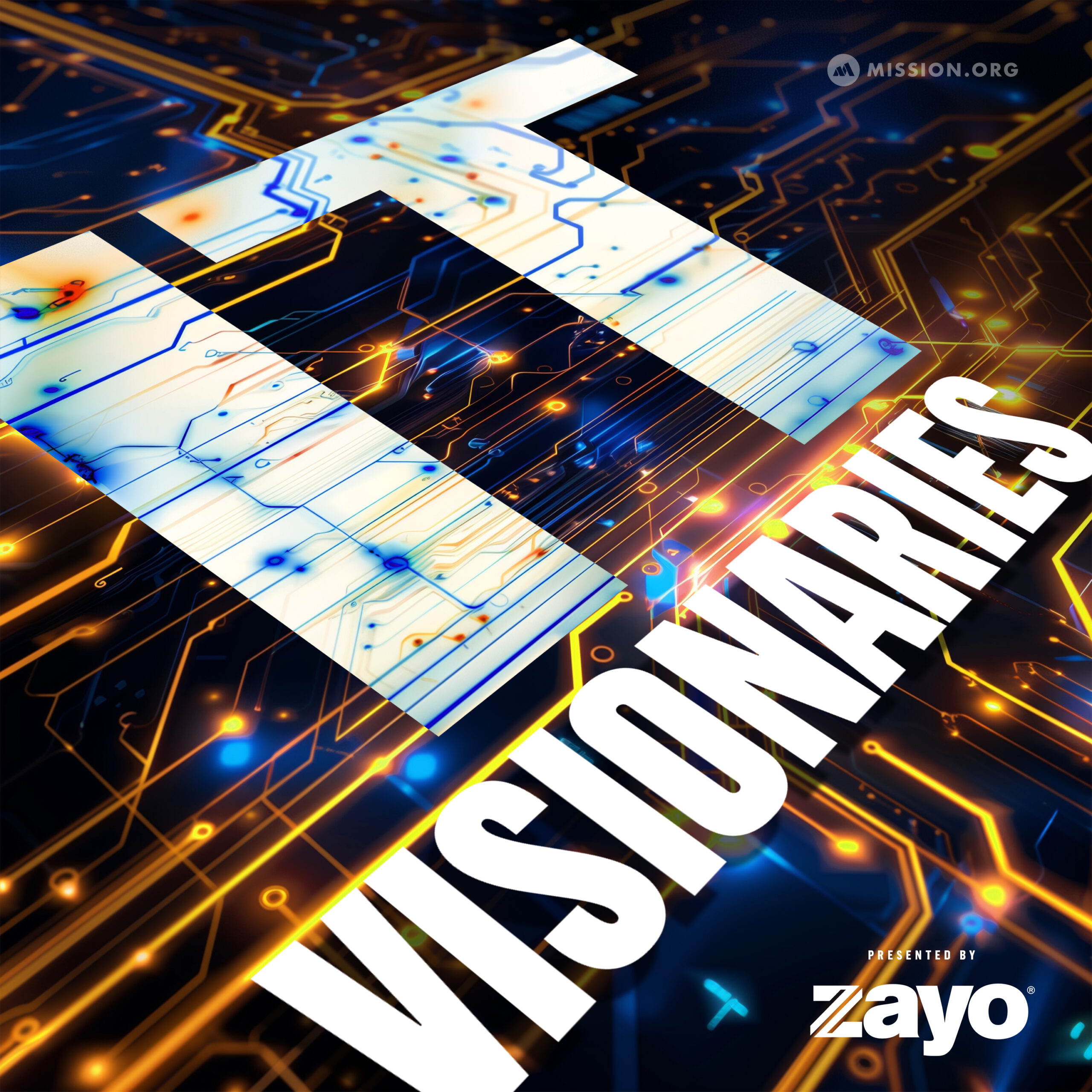Or listen in your favorite podcast app
Apple Podcasts / Google Podcasts / Stitcher
From tinkering with his first 486 SX computer in his early teens to becoming a senior solutions architect at AHEAD, Brantley Richbourg is continuing to eat, sleep, and breath computers. Like all fellow computer nerds, curiosity is his driving force. At an early age, Brantley was stringing pieces of yarn all across his childhood home. Strand by strand, Brantley’s curiosity of connecting things slowly trickled into technology as he grew up. And as a senior solutions architect, Brantley continues to find himself connecting AHEAD’s clients to the cloud. In this episode of IT Visionaries, Brantley delves into the current state of digital transformations into the cloud, the importance of edge computing, and how Brantley handles pushback.
Best Advice: “Get comfortable being uncomfortable. Don’t be afraid to get out there. Grow or die.”
Key Takeaways:
- Details on digital transformations for enterprise companies
- The future of edge computing and 5G
- Advice on overcoming pushback
Brantley’s origins
Since he was 13 years old, Brantley has considered himself a computer nerd. His first computer was a 486 SX that his mom bought for him. From then on, Brantley had a natural passion for computers and once Brantley made it to high school, he knew he wanted to get into networking.
“I think there’s been some fascination with connecting all my life and networking was a natural way to do that with technology. In high school, I knew I wanted to get into networking and then I kinda started going more down that path.”
All things AHEAD
Brantley’s role at AHEAD is centered around cloud connectivity. His responsibilities, by and large, are to help clients connect to the cloud in a frictionless way. Brantley points out that this is not a simple task. Some of AHEAD’s customers are enterprise companies and connecting these larger clients to the cloud can be a lot of work due to the sheer amount of data or legacy systems that need to switch over. But not all of AHEAD’s customers are enterprise companies, in fact, they run the gamut in size and industry. But, AHEAD mostly works with companies in the healthcare and financial services verticals and other smaller government companies.
“A lot of our customers are in a boat where we have a large data center footprint and we’re trying to figure out how to leverage the cloud and their business, and how they use DevOps and agile methodologies in order to become more agile and to deploy services quicker.”
“Larger enterprises are a little slower to change because of some of the regulations that they might be under or some of the policies that they have that have been there for years. And those have to be changed. A lot of it has to do with figuring out what regulations and different criteria do they have to govern themselves by and how can they adopt the cloud in a way that still is productive and still helps enable the business to do more faster. Also, we have to be able to do it in a secure manner and in a manner in which they can still rein in the controls around the cloud.”
Digital transformation
“People are naturally resistant to change.”
Brantley mentions that the resistance to initiate a digital transformation to the cloud becomes even stronger as you move down lower in the ranks. Specifically, Brantley points out that architect and engineering levels at some larger enterprise companies are somewhat against change for a number of reasons. Intimidation, not wanting to learn cloud computation, and time are some of the resistances that Brantley talks about what he’s noticed when working with some of his clients.
“I see [digital transformation into the cloud] more as a people issue and a process issue than I do a technology issue.”
Every company has specific needs and so the use cases will be unique on a customer-to-customer basis.
A customer example Brantley shares was about a customer who was splitting their company into two separate entities. Because of this, the customer also wanted to shut down the data centers that were running part of the business. Keep in mind that this company also had a very short runway. This is a use case where Brantley explains that lift and shift would be an appropriate strategy. Lift and shift is essentially one strategy of “transformation” in the phrase, “digital transformation.” This strategy is a crowd-favorite in particular because, during the transformation, Brantley and his team don’t have to redesign the operations of the asset in a way that would change the workflow of that system.
The first step before you move your company to the cloud is to get your metaphorical t-shirt size. Brantley says you need to size up how big or small your VM is and figure out the utilization of those machines, then see if you’re able to turn them down a bit. He points out that a lot of virtual machines and systems have been over-provisioned and that over-provisioning is not a big deal when you don’t have utility bills that are associated with running them in your traditional infrastructure.
On the flipside, Brantley explains that, “when you start to leverage other services that the cloud offers, that’s when you start to really gain the true power of cloud and start to take some of the mundane tasks away from IT workers who are maintaining operating systems for database servers and things like that as an example. And we can just leverage the cloud and let them manage it, then your architects and your engineers can focus on more innovative tasks within the business that may help drive more revenue.”
“Azure is a data center that we can leverage in that sense and we can migrate the workloads there for this example. For the short term, lift and shift is great for things like this. In the long term though, it changes the financial model of how you pay for your IT assets. And a lot of people want to move to the cloud because it’s an operational expenditure and that’s desired. But I can guarantee you that if you run a workload on-prem and you run it in the cloud, or a whole set of those workloads are running on-prem and you just lift and shift them to the cloud without any kind of right-sizing or consideration of how the cloud operates, it’ll probably be more expensive to do. That’s the bad thing about lifting and shifting. It’s not cost-effective to move to the cloud if you’re just going to continue as business as usual.”
Pushback Brantley faces
Brantley is someone who always likes to ask why. He believes that when you’re asking why, you get answers that move you toward first-principles and allows solutions to problems to become more clear. He believes that the more an organization knows its why, the more time and money that organization can save.
“Sometimes the message and the reasoning that an organization wants to move to the cloud doesn’t necessarily trickle down to all of the people that are going to be involved.”
“This isn’t always a technology thing, but it’s a constant people thing. Raw, constructive criticism is healthy, no matter where you are in the organization. If more IT leaders could do that, it would waste less time and solve more problems.”
“People want control. So, these security teams don’t trust these new cloud teams that are being built and they don’t trust the cloud. It’s really a people problem. Technology is technology. The cloud works. It’s really a people issue when it comes to adopting the cloud for these larger enterprises. They are either scared of it, they don’t trust it, or they’re afraid they’re going to lose their job. People think to themselves, ‘I’m no longer going to have a place because the cloud’s going to take my job,’ which is absolutely not true. The cloud is not going to take your job. People were scared about virtualization and thought it was going to take their job and look, it ended up creating more jobs. I think the cloud is going to create more jobs. I think it’s just you as an individual, have to be willing to learn new skills and be a little flexible.”
The edge and its importance
“I do see that it’s going to probably shift because if you think about it historically speaking, computing used to be centralized. Mainframes, for example, were highly centralized. And then we went to a distributed model where we started going into client-server type typologies. The kind of systems that are used today, but those were distributed across your enterprise and your equipment. And we’re still kind of doing that, but now a lot of the servers are starting to centralize again in the cloud. In this sense, instead of running it on our own equipment, we’re now running it on someone else’s equipment. Even though it’s still distributed, logically, it’s kind of physically starting to centralize again. And so I think as we develop applications that need lower latency times or faster response times, I think you’re going to have to leverage computing power closer to the user.”
“Networking-wise, the cloud providers have much more distributed edge locations than they do regions where they run computing power. And so as that 5G trend becomes more popular and we need computing closer to the user, I can completely see cloud providers building out more computing resources in these edge locations to get those types of resources closer to the user then you can get in their main regions.”




